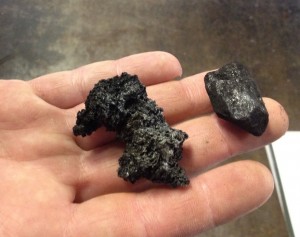Blacksmithing 3.014—MIT Loves Hot Metal
-
-
slice.mit.edu
- 1
Filed Under
Recommended

Mike Tarkanian ’00, SM ’03, a lecturer in the Department of Materials Science and Engineering, is a friendly bearded man with a shaved head and the stout hands of a smith. He honors an ancient practice, standing in a basement room in Building 4, surrounded by anvils, cabinets full of hammers and tongs, a coal bin, and the three barbeque-grill-sized forges that he oversees.
“There’s something about heating things up and smashing them with a hammer that’s universally appealing,” he adds.
That clearly holds true at the Institute, where hundreds of students apply annually for 54 openings in Tarkanian’s IAP class in blacksmithing, and dozens of MSE students work at the forges every semester as part of their Materials Laboratory (3.014) and Materials in the Human Experience (3.094) classes. Tarkanian and MSE Professor Sam Allen also offer a Freshman Advisor Seminar to about a half-dozen incoming students each year.

On one level, working at a forge provides deeper comprehension of things like the effects of carbon content on steel or the difficulties of making alloys. But more broadly, says Tarkanian, “craft-based, history-based teaching gives engineers a human connection and a social context.”
Moreover, adds Tarkanian, who discovered the forges as a freshman working with his predecessor, Toby Bashaw, the experience provides important insights for engineering management, especially in manufacturing. “A student who graduates and becomes a boss is much better off if they’ve made things—whether it’s forging or machining or 3-D printing. You need to know the possibilities and the pitfalls, the importance of sequencing, the details that make something look professional. If you don’t, you won’t be effective and you can look foolish.”
Currently, MIT’s forges share space with the MIT Glass Lab. A proposed renovation would incorporate a room across the hall for an expanded metalworking facility and give the Glass Lab the entirety of room 4-003.
While the bigger space might incorporate some gas-fired forges and pneumatic hammers, Tarkanian says basic forges, not unlike those of 6,000 years ago, will remain the program’s centerpiece. “Managing a coal fire and using traditional tools helps people learn the craft better,” he says.
“Today a lot of people are asking, what’s the role of residence-based education,” notes Tarkanian. “Well, it’s stuff like this—you can’t hammer steel through your computer.”








Comments
Ezeagu Chidulue
Sun, 05/12/2013 7:20am
That's a good idea, but modern technology had made almost everybody not remincent of the origin